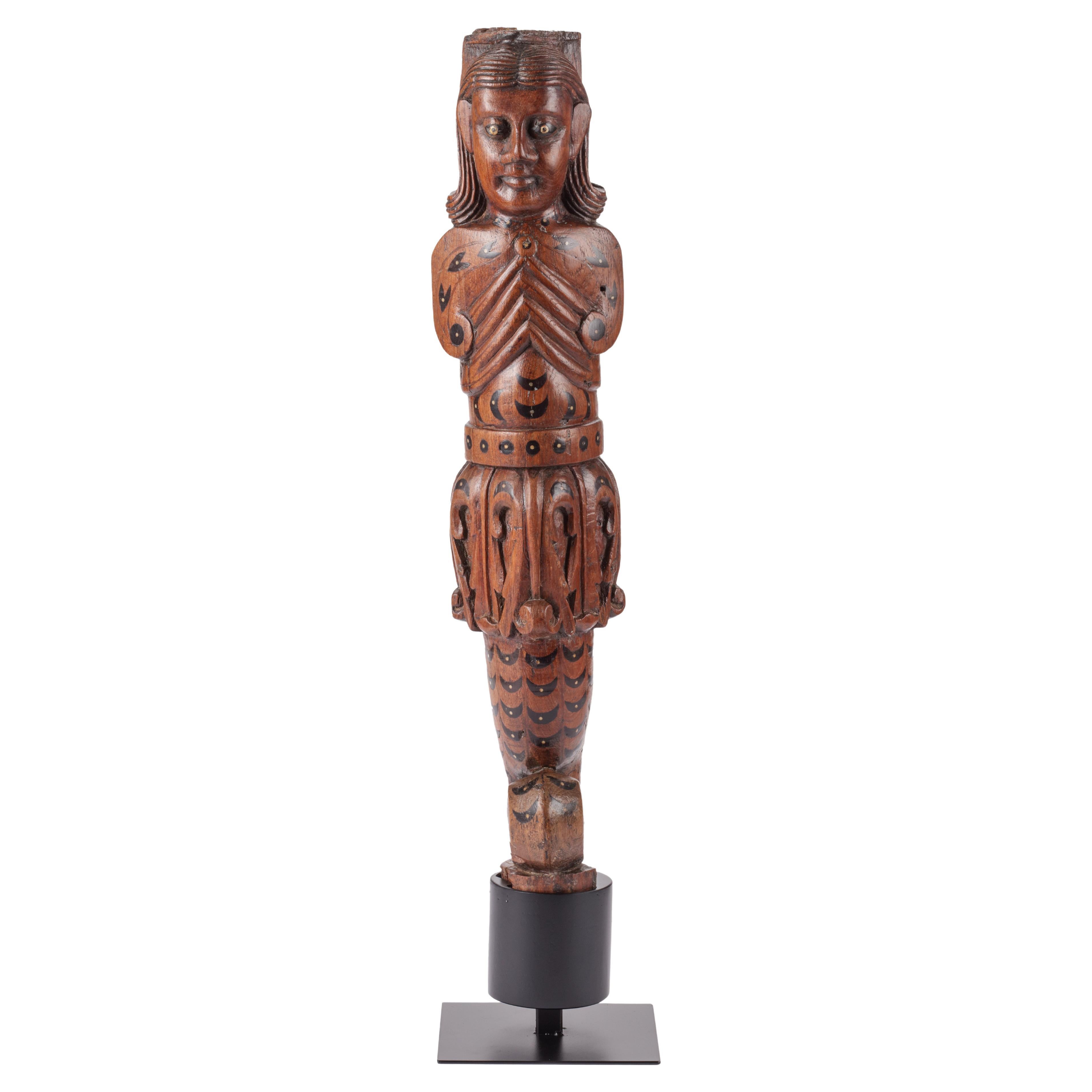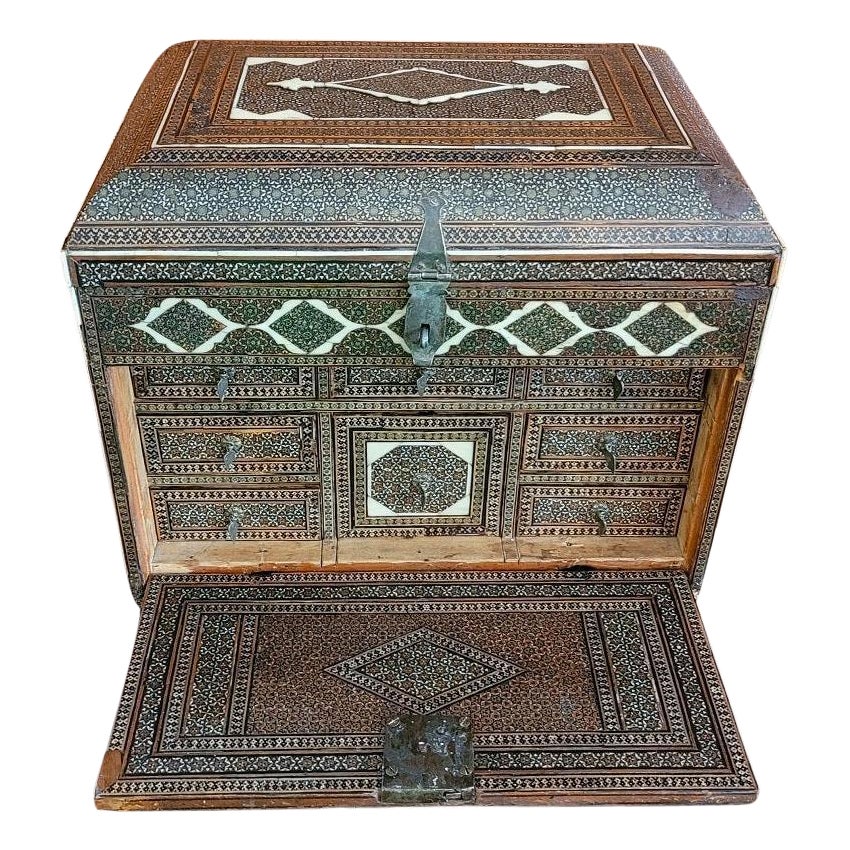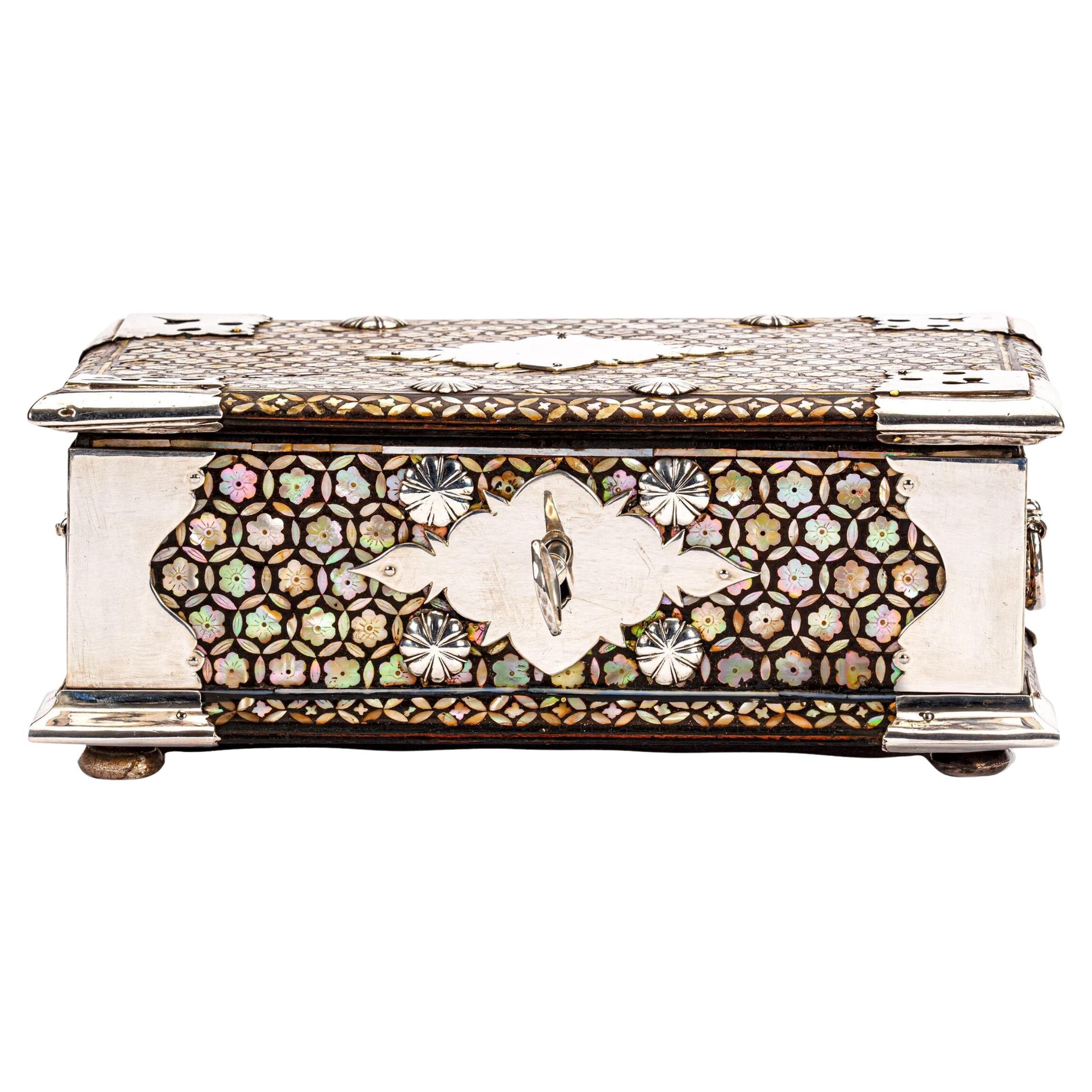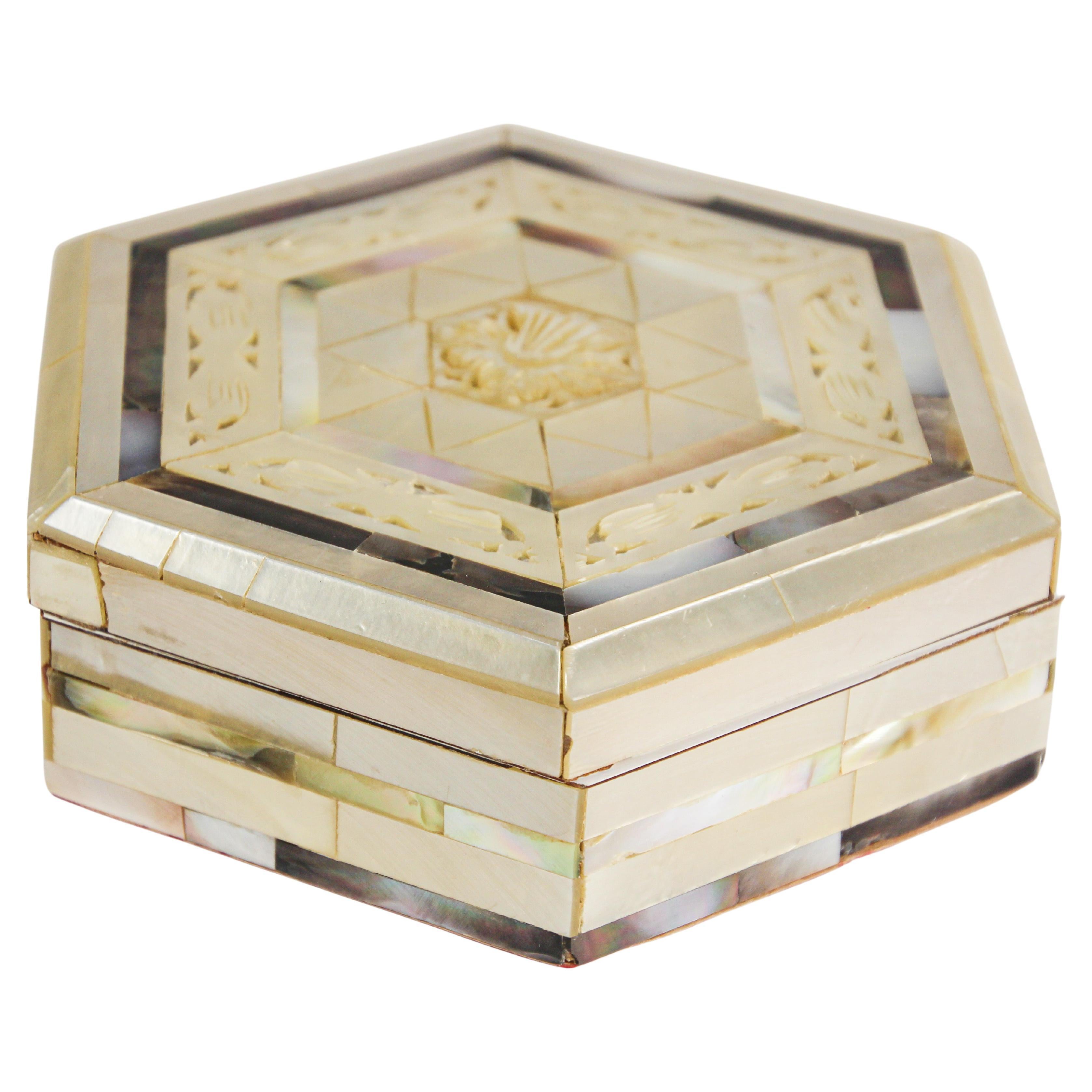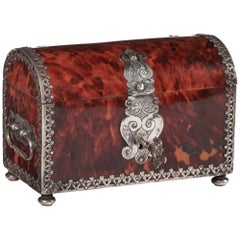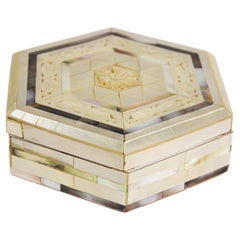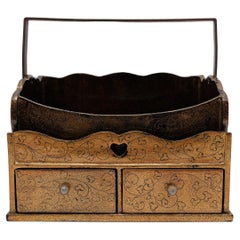Items Similar to 16th-Century Indo-Portuguese Colonial Mother-of-pearl Gujarat Casket
Want more images or videos?
Request additional images or videos from the seller
1 of 9
16th-Century Indo-Portuguese Colonial Mother-of-pearl Gujarat Casket
About the Item
An exceptional Indo-Portuguese colonial mother-of-pearl veneered casket with silver mounts
India, Gujarat, 2nd half of the 16th century, the silver mounts Goa or probably Lisbon
Measures: H. 16 x W. 24.6 x D. 16.1 cm
An exceptional Gujarati casket with a rectangular box and truncated pyramidal lid (with slopes on each side and a flat top) made from exotic wood, probably teak (Tectona grandis), covered with a mother-of-pearl mosaic. The tesserae, cut from the shell of the green turban sea snail (Turbo marmoratus, a marine gastropod) in the shape of fish scales, are pinned to the wooden structure with silver ball-headed nails. The casket is set on bracket feet on the corners. The masterfully engraved decoration of the silver mounts follows the most refined and erudite Mannerist repertoire of rinceaux and ferroneries dating from the mid-16th century. The high quality and refinement of the silver mounts and, likewise, the silver nails that replaced the original brass pins used to hold the mother-of-pearl tesserae in place indicate the work of a silversmith probably working in Lisbon in the second half of the 16th century.
The Indian origin of this production, namely from Cambay (Khambhat) and Surat in the present state of Gujarat in north India, is, as for the last three decades, consensual and fully demonstrated, not only by documentary and literary evidence - such as descriptions, travelogues and contemporary archival documentation - but also by the survival in situ of 16th-century wooden structures covered in mother-of-pearl tesserae. A fine example is a canopy decorating the tomb (dargah) of the Sufi saint, Sheik Salim Chisti (1478-1572) in Fatehpur Sikri in Agra district in the state of Uttar Pradesh, north India. This is an artistic production, geometric in character and Islamic in nature, where usually the mother-of-pearl tesserae form complex designs of fish scales or, similar to the dishes also made using the same technique, with the thin brass sheets and pins, stylized lotus flowers. The truncated pyramidal shape corresponds, like their contemporary tortoiseshell counterparts also made in Gujarat, to a piece of furniture used in the Indian subcontinent within the Islamic world prior to the arrival of the first Portuguese. This shape, in fact, is very old and peculiar to East-Asian caskets, chests or boxes used to contain and protect Buddhist texts, the sutras.
A similar chest is the famous and large reliquary chest from Lisbon cathedral that once contained the relics of the city's patron saint, Saint Vincent. Both match in shape, having the same kind of socle or pedestal and bracket feet, and in their engraved silver mountings, featuring the same type of refined, erudite decoration. Their differences lie in the silver borders that frame the entire length of the edges of the chest (both the box and the lid), pinned with silver nails, and on the lock plate, shaped like a coat of arms in the Lisbon example. Given the exceptional dimensions of the reliquary casket from Lisbon cathedral (48 x 65 x 42 cm), the goldsmith responsible for its mounting opted to place two bracket-shaped side handles instead of a top handle, as in our casket. Another similar example, probably mounted in the same Lisbon workshop as the other examples from this small group, belongs to the Seville Cathedral and remains almost unknown. It shares many features in common with the one in the Lisbon cathedral, namely the use of engraved silver borders running along the edges, protecting the casket. An aspect that distinguished it from the others is the use of tesserae cut from Turbo marmoratus, which show a higher iridescence but also cut from the shell of the pearl oyster, probably Pinctada radiata or Pinctada maxima, given the whitish hue of the base colour. Nevertheless, the type of square-like lock plate is similar to our casket.
Another example, slightly larger but with less silver mounts, is in the collection of the Kunstkammer Wien in the Kunsthistorischen Museums in Vienna and belonged to the Habsburger Family. The same type of large silver ball-headed nails seems to be characteristic of this small, rare and important group, of which the present example is the second known example in private hands, given that the others have been in their current place since the time they entered their collections in the late 16th century or the first years of the 17th century.
- Dimensions:Height: 6.3 in (16 cm)Width: 9.69 in (24.6 cm)Depth: 6.34 in (16.1 cm)
- Materials and Techniques:
- Place of Origin:
- Period:
- Date of Manufacture:circa 1550-1560
- Condition:Wear consistent with age and use.
- Seller Location:Amsterdam, NL
- Reference Number:1stDibs: LU5458231674382
About the Seller
5.0
Vetted Seller
These experienced sellers undergo a comprehensive evaluation by our team of in-house experts.
Established in 1985
1stDibs seller since 2020
19 sales on 1stDibs
Typical response time: 4 hours
- ShippingRetrieving quote...Ships From: Amsterdam, Netherlands
- Return PolicyThis item cannot be returned.
Authenticity Guarantee
In the unlikely event there’s an issue with an item’s authenticity, contact us within 1 year for a full refund. DetailsMoney-Back Guarantee
If your item is not as described, is damaged in transit, or does not arrive, contact us within 7 days for a full refund. Details24-Hour Cancellation
You have a 24-hour grace period in which to reconsider your purchase, with no questions asked.Vetted Professional Sellers
Our world-class sellers must adhere to strict standards for service and quality, maintaining the integrity of our listings.Price-Match Guarantee
If you find that a seller listed the same item for a lower price elsewhere, we’ll match it.Trusted Global Delivery
Our best-in-class carrier network provides specialized shipping options worldwide, including custom delivery.More From This Seller
View AllSplendid Indo-Portuguese Colonial Sculpture of Nagini from Goa, 17th Century
Located in Amsterdam, NL
A fine Indo-Portuguese inlaid teak wood figure of Nagini
India, Goa, 17th century
Measure: H. 55 cm
(with stand, and with ring for wall hanging)
The sculpture can be perceived as such but probably is one of four legs of an Indo-Portuguese contador...
Category
Antique 17th Century Indian Jewelry Boxes
Materials
Ebony, Teak
An Indo-Portuguese colonial tortoiseshell veneered wooden casket
Located in Amsterdam, NL
India, probably made in Gujarat for Portuguese Goa, late 17th/early 18th century
The tortoiseshell laid over gold foil, and the interior with red lacquer and possibly later added re...
Category
Antique Late 17th Century Indian Jewelry Boxes
Materials
Silver
18th-century Dutch-colonial Peranakan mother-of-pearl casket with silver mounts
Located in Amsterdam, NL
An Indonesian Peranakan mother-of-pearl inlaid mastic sirih casket with silver mounts
Jakarta (Batavia), circa 1720-1730, the silver hinges marked for Batavia, maker’s mark HS or SH...
Category
Antique Mid-18th Century Indonesian Dutch Colonial Antiquities
Materials
Silver
Colonial Islamic Arabian Market Jewelry Box, 18th Century, India/Malabar Coast
Located in Amsterdam, NL
AN INDIAN ROSEWOOD AND EBONY BRASS MOUNTED BOX FOR THE ISLAMIC MARKET
Malabar Coast, 18th century
With a large drawer with several compartments under a lid with two com...
Category
Antique 18th Century Indian Islamic Jewelry Boxes
Materials
Brass
18th century Dutch-Colonial ‘Vizagapatam’ pen-engraved bone inlaid ebony box
Located in Amsterdam, NL
A large Indian Colonial ‘Vizagapatam’ pen-engraved bone inlaid ebony box
Masulipatnam or Vizagapatam, 2nd half 18th century
H. 10.8 x W. 47 x D. 34 cm
...
Category
Antique Late 18th Century Indian Dutch Colonial More Asian Art, Objects ...
Materials
Bone, Ebony
17th century colonial Sinhalese ebony two-door cabinet with silver mounts
Located in Amsterdam, NL
A splendid Dutch-colonial Sinhalese ebony two-door cabinet with silver mounts
Sri Lanka, Kandy, 2nd half 17th century, the mounts later
The cabinet with a central drawer with hidde...
Category
Antique 17th Century Sri Lankan Dutch Colonial Jewelry Boxes
Materials
Silver
You May Also Like
18 C, Indo-Portuguese Vargueno Mini Cabinet
Located in Dallas, TX
Presenting a fabulously rare 18c Indo-Portuguese Vargueno mini cabinet.
Extremely rare, highly important and desirable colonial piece !
It is an In...
Category
Antique Late 18th Century Indian Anglo-Indian Decorative Boxes
Materials
Brass
Ancient Jain Altarpiece with Three Standing Jina's, Gujarat, India 16th Century
Located in Antwerp, BE
An authentic, ancient and exceptional Three Jina Shrine. For it’s age the altarpiece is in a very good condition and rather large. The image of three standing, nude Jinas flanked by the other 21 seated Jinas is rare. The lintel of the shrine is showing the nine comets and three seated figures...
Category
Antique 16th Century Indian Medieval Antiquities
Materials
Bronze
Handcrafted White Mother of Pearl Inlaid Moorish Octagonal Box
Located in North Hollywood, CA
Exquisite handcrafted white mother of pearl inlaid and hand carved lidded box.
Small octagonal Anglo Indian decorative box intricately decorated with Moorish motif designs which hav...
Category
Mid-20th Century Indian Moorish Decorative Boxes
Materials
Shell, Fruitwood, Abalone, Mother-of-Pearl
Japanese Gilt Tabako-Bon with Mother-of-Pearl Inlay
Located in Chicago, IL
This handled box is a Japanese tabako-bon, or 'tobacco tray,' used to store tobacco and smoking accessories. Believed to have evolved from the traditional...
Category
Mid-20th Century Japanese Decorative Boxes
Materials
Mother-of-Pearl, Wood
Indochinese Box in Wood and Mother of Pearl circa 1900
Located in Beuzevillette, FR
Nice wooden and mother-of-pearl box from the 1900s. The mother-of-pearl inlays form plant motifs (flowers and foliage), incised to give volume to the different parts. It closes with ...
Category
Antique Late 19th Century Asian Decorative Boxes
Materials
Wood
Japanese Momoyama Period Black Lacquer and Mother of Pearl Box, 16th Century
Located in Austin, TX
A fine and unusual Japanese black lacquer and mother of pearl inlaid box, Momoyama Period, 16th century, Japan.
The large box and cover featu...
Category
Antique 16th Century Japanese Edo Lacquer
Materials
Lacquer, Abalone
Recently Viewed
View AllMore Ways To Browse
Pin Box
Mother Of Pearl Hand
Pin With Box
Old Antique Jewelry Boxes
Antique Mother Of Pearl Furniture
Mother Pearl Box
Mother Of Pearl Box
Silver Jewelry Box Small
Small Silver Jewelry Boxes
Oyster Box
Old Colonial
Portugal Jewelry
Portugal Jewlery
Portuguese Jewellery
Jewellery Portugal
Portuguese Cut
Mother Of Pearl Jewlery Box
Decorative Canopy
